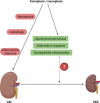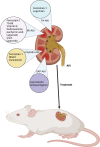Targeting ferroptosis in acute kidney injury
- PMID: 35210424
- PMCID: PMC8873203
- DOI: 10.1038/s41419-022-04628-9
Targeting ferroptosis in acute kidney injury
Abstract
Acute kidney injury (AKI) is a major public health problem with high incidence and mortality. As a form of programmed cell death (PCD), ferroptosis could be considered as a process of iron accumulation and enhanced lipid peroxidation. Recently, the fundamental roles of ferroptosis in AKI have attracted much attention. The network mechanism of ferroptosis in AKI and its roles in the AKI to chronic kidney disease (CKD) transition is complicated and multifactorial. Strategies targeting ferroptosis show great potential. Here, we review the research progress on ferroptosis and its participation in AKI. We hope that this work will provide clues for further studies of ferroptosis in AKI.
© 2022. The Author(s).
Conflict of interest statement
The authors declare no competing interests.
Figures





References
-
- Mehta RL, Pascual MT, Soroko S, Savage BR, Himmelfarb J, Ikizler TA, et al. Spectrum of acute renal failure in the intensive care unit: the PICARD experience. Kidney Int. 2004;66:1613–21. - PubMed
-
- Waikar SS, Curhan GC, Wald R, McCarthy EP, Chertow GM. Declining mortality in patients with acute renal failure, 1988 to 2002. JASN. 2006;17:1143–50. - PubMed
-
- Hoste EA, Bagshaw SM, Bellomo R, Cely CM, Colman R, Cruz DN, et al. Epidemiology of acute kidney injury in critically ill patients: the multinational AKI-EPI study. Intensive Care Med. 2015;41:1411–23. - PubMed
Publication types
MeSH terms
Grants and funding
LinkOut - more resources
Full Text Sources
Medical
Research Materials

